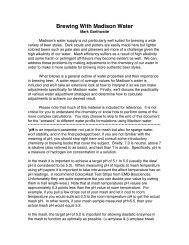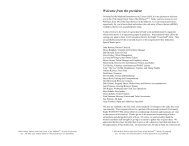The Compleat Distiller
The Compleat Distiller
The Compleat Distiller
Create successful ePaper yourself
Turn your PDF publications into a flip-book with our unique Google optimized e-Paper software.
THE COMPLEAT DISTILLER 76<br />
Beyond this, we don't want to belabor the point. Good safety equipment is no substitute for common<br />
sense! If you develop your workshop beyond the basics, then you will be bombarded with sound safety<br />
advice from other sources, be it from the manufactures of the equipment you buy, or from instructors at<br />
classes you may attend.<br />
However, we'd like to add just one word of caution. In any activity or line of work, the most dangerous<br />
phase is after you develop skills and familiarity, and caution begins to lapse. Many people have been<br />
badly hurt or killed by bad habits that built up bit by bit as they gained confidence and experience. Be<br />
forewarned, and guard against this tendency.<br />
Some basic requirements<br />
What do you need to get started? A place to work, something to hold the pieces being worked on, and<br />
a few basic tools will allow you to make a surprising number of quite complicated things. Of course,<br />
the better the workspace and the tools, the easier many tasks will become. As with all hobbies, it is<br />
best to start with the basics and try your hand. If you are having fun and making progress, you will<br />
find it far easier to justify each acquisition of more and better tools and equipment.<br />
<strong>The</strong> following list of tools is basic, and by no means comprehensive. You may need only a few of<br />
them, so we've tried to give the list some sort of "priority" based on what we find useful. Your<br />
priorities may be different, depending on what you're trying to do.<br />
• Safety goggles<br />
• Ruler, marked in both inches and centimeters.<br />
• Hacksaw, with fine metal-cutting blade.<br />
• Screwdrivers, both flat and Phillips head (cross-head).<br />
• Hammer.<br />
• Pliers − especially a set of waterman’s pliers (slip-joint type)<br />
• Leather workshop gloves (use them when handling hot components)<br />
• Vice and/or a couple of vise-grip pliers.<br />
• Hand drill, preferably a rechargeable hand-held electric drill.<br />
• Files, as many different types as you can get.<br />
• Adjustable wrench.<br />
• Emery paper − rough and fine grades.<br />
• Center punch.<br />
• A set of good quality drill bits, both metric and inch sizes<br />
• Hand-held propane torch<br />
• Lead-free solder and flux.<br />
• Wire brush.<br />
• Carpenter’s square.<br />
• Wood saw.<br />
• Vernier calipers (extremely useful for measuring tubing − cheap yet accurate digital ones are<br />
widely available).<br />
Add to this one of those folding "Workhorse" benches if your space is limited. <strong>The</strong>se are the type<br />
which feature a "vise top", and are sometimes called "mitre benches", with guides for angle cuts.<br />
<strong>The</strong> hand drill is the only power tool you may need at first. If you take on many projects, you will<br />
quickly want to move up to a good quality drill press. By the time you get around to lathes, milling<br />
machines and welding gear, you'll probably be able to teach us a few things about workshop<br />
techniques!<br />
One readily available tool that will allow an amateur to “fudge” a little or a lot is a Dremel® Moto-<br />
Tool. This is a very small handheld cylinder with a rotating shaft that spins about 30,000 rpm. Many<br />
cutting wheels, brushes, grinders of various shapes, buffers, etc are available. With a little ingenuity<br />
you can do almost anything with it. It's so compact, you can put it away in a drawer for storage.









